Crustacean Species of the Lembeh Strait
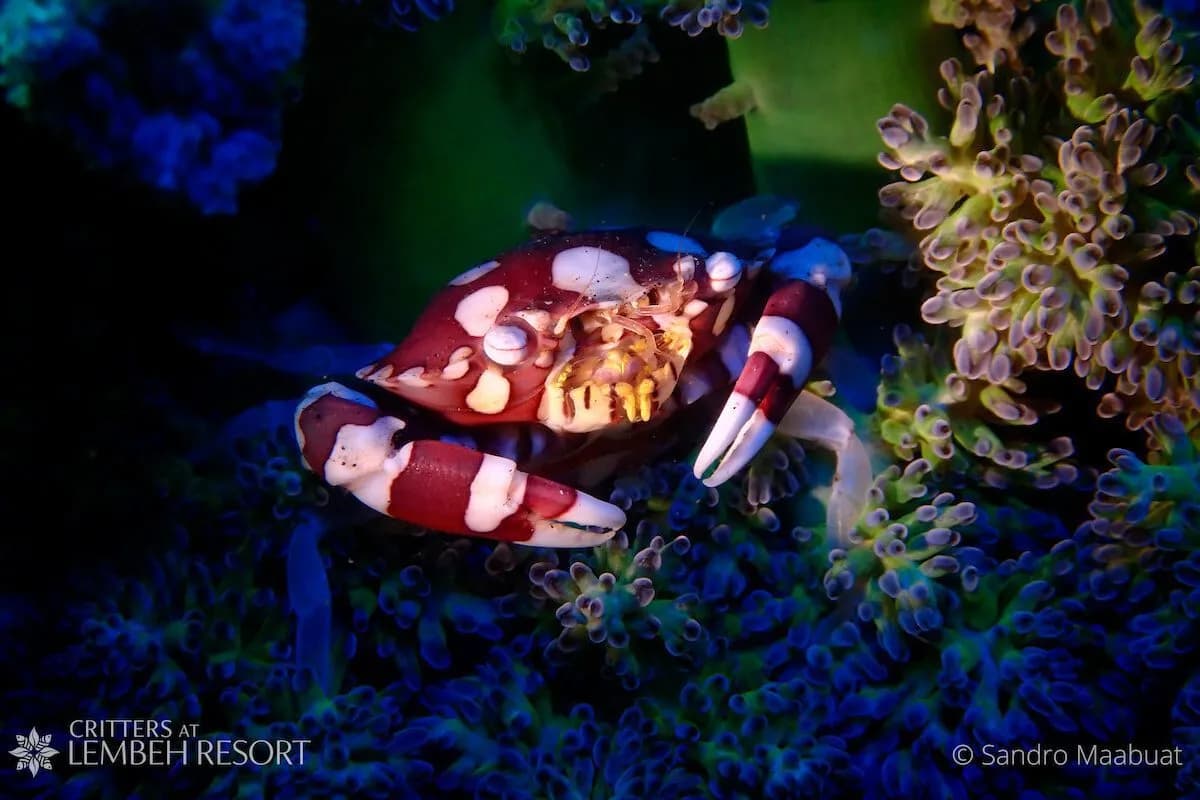
Diving in the Lembeh Strait not only reveals a myriad of rare and unusual fish and cephalopods, you’ll also be surprised to find that on some dives the number of crustacean sightings outweigh the number of other marine life sightings. The crustacean species of the Lembeh Strait range from the colorful and beautiful to the downright weird and alien looking with eyes on stalks, menacing looking pincers and armour plated like shells.
Pink-Eared mantis shrimp (Odontodactylus latirostris)
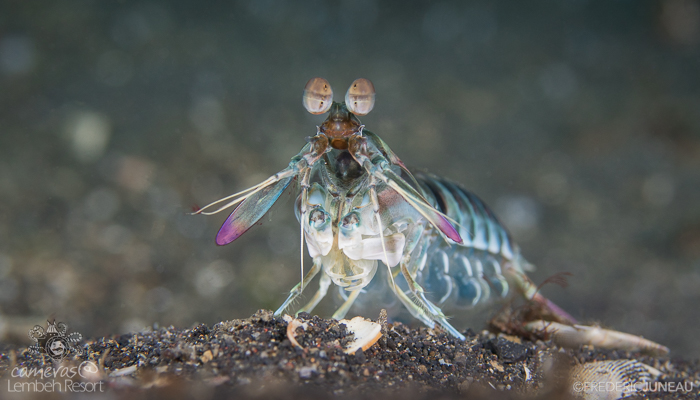
The pink eared mantis shrimp is a smasher species of mantis
One of the smaller species of mantis shrimp that we find in the Lembeh Strait and also one of the coyest. The female and male of this crustacean species have slightly different colored body scales. The females are pink to purplish whereas the males are a more mottled greenish brown with reddish highlights. This species takes its name from the pink hue of it’s “ears” which are actually the mantis shimps’ flat teardrop-shaped antennal scales.
Fact: Mantis shrimps fall in to one of two categories according to how they hunt their prey. They are either “smashers” or “spearers” The pink-eared mantis shrimp is a smasher species which means it stuns it’s prey by using it’s modified second pair of front legs to strike it’s victim. The strike is even faster than that of the mantis insect and takes only a fraction of the time of a blink of the eye. The force and speed of a smasher’s strike has been compared to the power and acceleration of firing a .22 caliber bullet!
Dive Sites: When you are diving in Lembeh you will find that the pink-eared mantis shrimps favor rubble and sand patches in which they can burrow. The best Lembeh Strait dive sites for sightings of this crustacean are Nudifalls, Air Prang, Jahir and Hairball sites, Lembeh Resort House Reef and Tanjung Kubur.
Spiny Tiger Shrimp – (Phyllognathia ceratophthalmus)
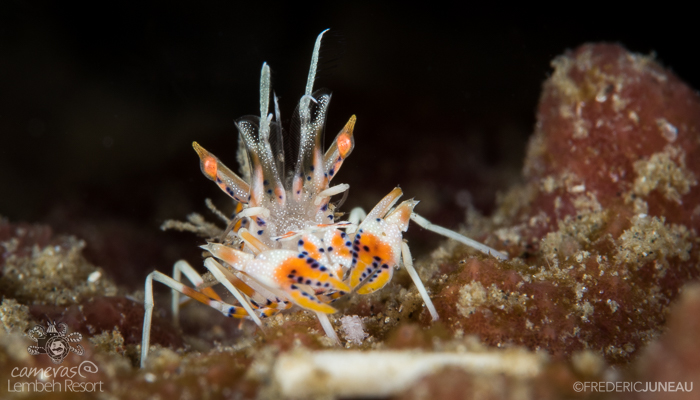
The tiny tiger shrimp is a rare find as it is exceptionally shy and tends to hides away in caves and recesses
This tiny species of colorful shrimp grows up to just 2cm and has a highly distinctive appearance. It’s translucent white body is covered with orange blotches and contrasting blue dots. The legs and claw arms of the tiger shrimp are banded orange and white and it has unusually long eye stalks which add to it’s alien-like appearance.
This is a cryptic crustacean species which is found in Lembeh on algae, rubble and sponges. It is quite a rare find as it often hides in shady caves and beneath overhangs. The spiny tiger shrimp is carnivorous and feeds predominantly on sea stars and brittle stars.
Fact: Did you know that the spiny tiger shrimp (often just referred to as “tiger shrimp”) is closely related to Harlequin shrimp?
Dive Sites: Spiny tiger shrimps are found when we are Fhsing in Lembeh on our black sand dive sites which have smatterings of coral. The one pictured here was hiding in a small “cave” underneath a small outcropping of coral and rock. The best dive sites for sightings are Jahir 2, Lembeh Resort House Reef, Nudi Falls and Nudi Retreat.
Two Horn Box Crab (Calappa bicomis)
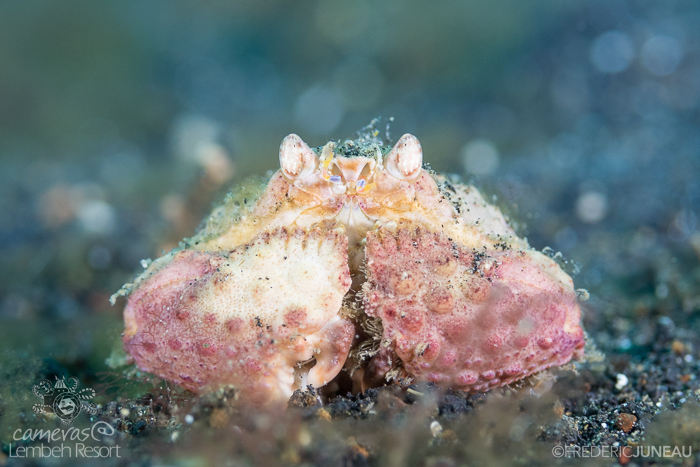
Shame-faced box crabs have a well defined, serrated upper edge on their claws
The two horn box crab is a species of “shamefaced box crabs”. This is a small species whose carapace (shell) grows to just 6.5cm. The two horn box crab is easily identified from other box crab species by the tubercles (warty like lumps) on it’s carapace. The scientific prefix to this crab’s name, “Calappidae”, denotes the box crab species.
This crustacean displays an orange to pink or multi-colored coloration and it’s carapace is almost exactly circular. The two horn box crab’s claws have a “serrated” upper edge with several well defined pointed teeth. The legs of this crab are red with highly distinctive white spots. Box crabs feed on mollusks, opening the shell with their powerful claws. They are only found occasionally and mainly on night dives.
Fact: Shame faced box crabs take their name from the way that they hold their claws in front of their faces as if ashamed of their appearance!
Dive sites: When diving in Lembeh Strait, we find this species on our black sand muck diving sites where is usually spotted om the sand or on rubble patches. The best sites for finding shame-faced box crabs are Air Prang, Jahir and Hairball dive sites as well as Pantai Parigi.
Harlequin Swimming Crab (Lissocarcinus laevis)
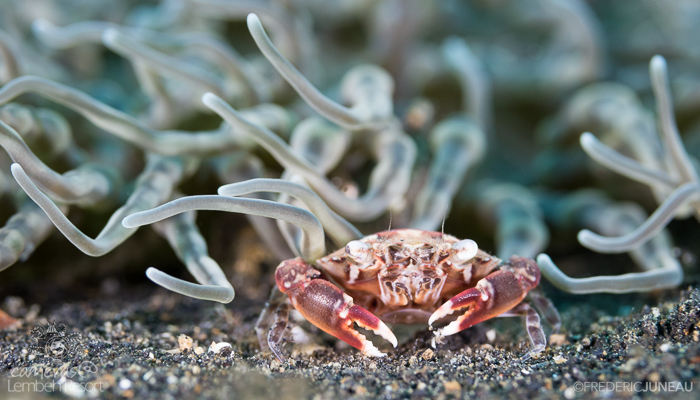
The harlequin swimming crab lives in symbiosis with tube anemones
This tiny yet ornate species of swimming crab has a highly distinctive appearance which features large white spots on it’s red carapace, red and white bands on it’s claw arms and whitish translucent legs. This species lives in symbiosis with tube dwelling anemones under which is takes cover to hide from predators.
Taking photographs of this species is not easy as it will usually scurry around the base of the anemone to the opposite side to where the camera is positioned. If the anemone is disturbed it will retract into it’s tube and the crab will burrow into the sand to take cover. When captured on camera however, this is a stunningly ornate species.
Fact: The latin name prefix “Lissocarcinus” refers to all species of swimming crabs with “laevis” being specific to the harlequin species. Did you know that harlequin swimming crabs only grow to a maximum carapace size of 3.5cm?
Dive Sites: This species is found on any dive site which is home to tube anemones. When diving in Lembeh Strait, our favorite sites for spotting harlequin swimming crabs are Goby a Crab, Hairball dive sites, Jahir 2, Lembeh Resort House Reef, Pantai Perigi and Nudifalls. This species is also found on our coral reef sites too.
Dark Knee Hermit crab (Dardanus lagopodes)
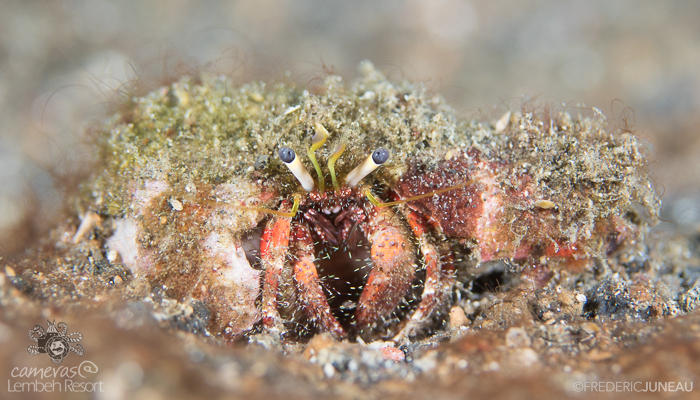
The Dark Knee Hermit Crab prefers shells with wide apertures
Dardanus crabs are better known as hermit crabs and there are numerous individual species which can be found in the Lembeh Strait. Hermit crabs take their name from their “hermit-like” habit of occupying the empty shells of other mollusks – this can also make them tricky to identify as the shell displays characteristics of whichever species it previously belonged to!
The dark knee species is a left handed hermit crab which has distinctive banded claws and arms, a mottled red to maroon carapace (shell) and characteristic yellowish eye stalks with black eyes. This species takes its name from the dark patch above the second section of it’s legs (not quite visible in this image). The legs, carapace and claws of this species are covered with white tipped dark bristles.
Fact: Did you know that as hermit crabs grow they will discard their shells periodically and find a larger replacement to accommodate them? This particular species favors shells with wide apertures. It will usually break open the shell and eat the mollusk inside prior to moving in!
Dive Sites: This species (and all hermit crab species) are relatively common around the Lembeh Strait but hot spots include: Air Prang and Hairball sites, Critter Hunt, Retak Larry, Lembeh Resort House Reef and Nudi Retreat. Hermit crabs are not just found when we are diving in Lembeh Strait – we see numerous species at our coral reef sites to the north and east of Lembeh Island and around Bangka Island.
Iconic Crustacean Species in Lembeh
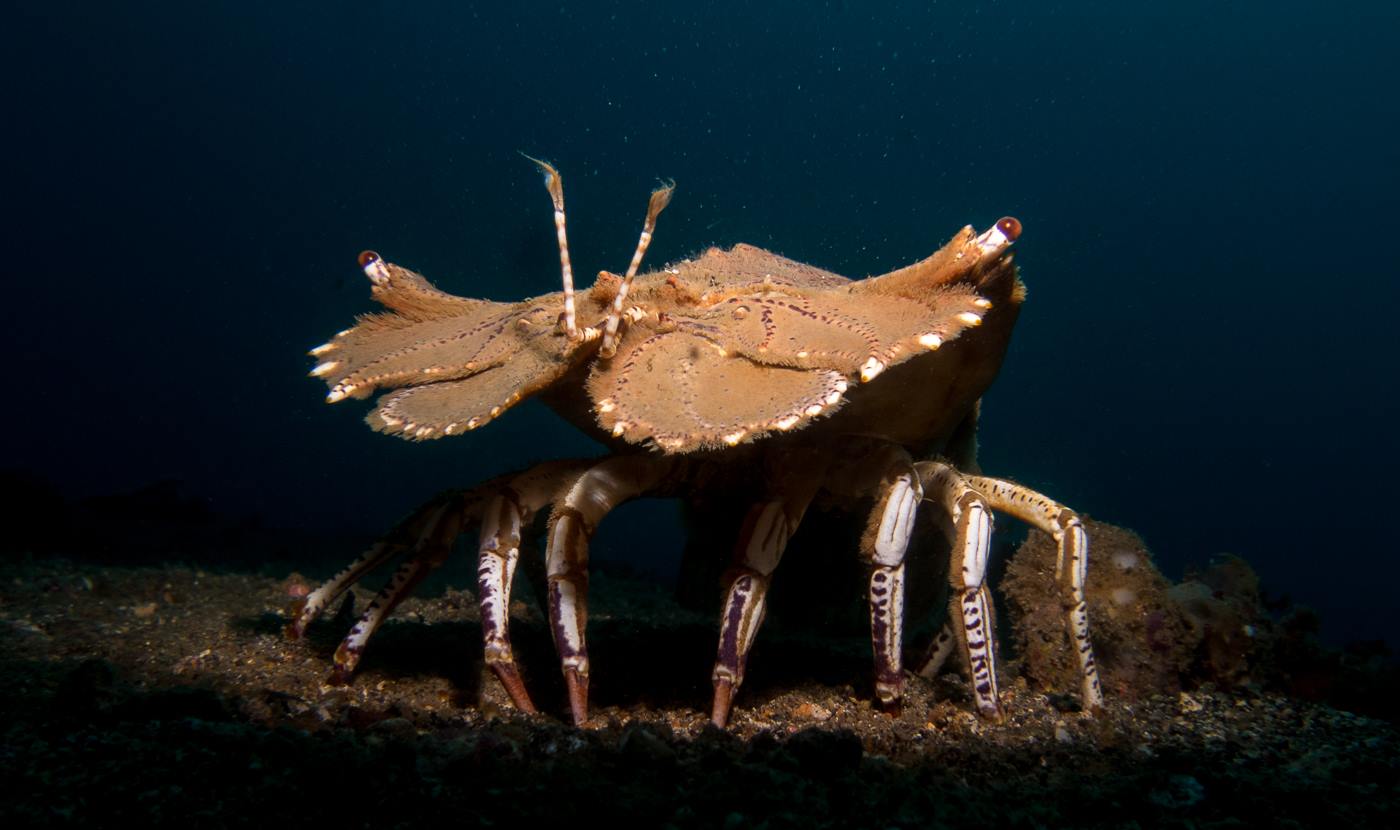
This slipper lobster image was taken by Dive Guide Opo Sedang
These are just five of the phenomenal range of crustaceans which we see when diving Lembeh Strait – other iconic crustacean species include: Harlequin shrimps, marble shrimps, orangutan crabs, broken back shrimps, commensal shrimps, cleaner shrimps, boxer shrimps, pomp pom crabs, soft coral crabs, decorator crabs, hairy squat lobsters, spiny lobsters, slipper lobsters (above), bumble bee shrimps, whip coral shrimps, emperor shrimps, skeleton shrimps and even tiny hairy shrimps – there are just too many to list!
Why not check out our full list of crustacean species in our searchable Critter Log?
Diving Adventure with Lembeh Resort
Are you planning your next trip to the Lembeh Strait? Set in a secluded private bay, Lembeh Resort offers luxury accommodation, exclusive service and exquisite dining combined with warm hearted North Sulawesi hospitality. Did you know that Lembeh Resort is the only dive resort in the Lembeh Strait to offer a full time, on-site Photo Pro, two marine biologists on staff to help with marine life identification and underwater photography and marine biology trained Dive Guides?
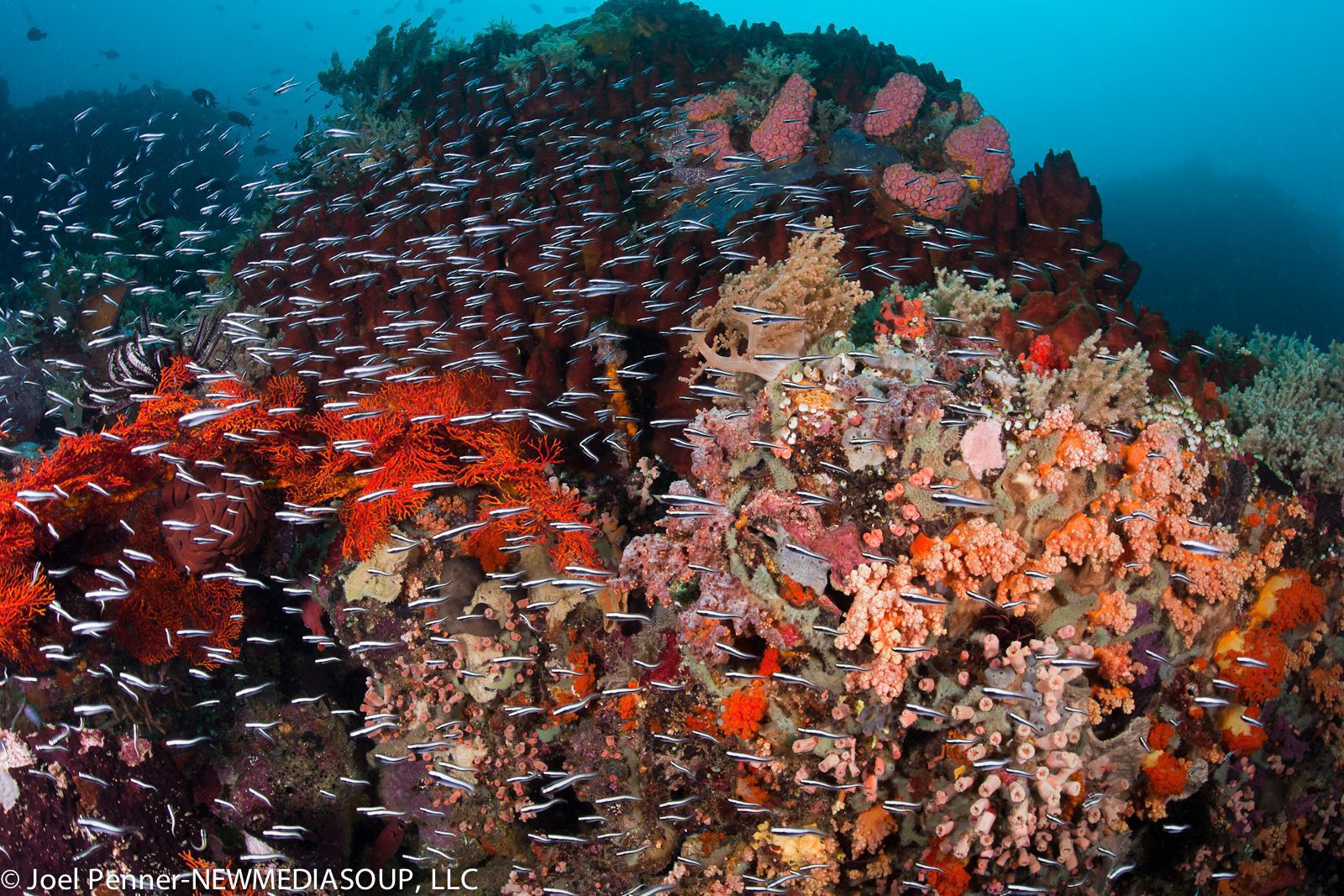
Bangka Island and East and North Lembeh are home to stunning coral reefs
In addition to being experts in the dive sites within the Lembeh Strait we also explore the beautiful reefs and pinnacles of further afield, including offering day trips to the kaleidoscopic sites surrounding Bangka and the far east coast of Lembeh Island.
If you’d like more information about staying and diving rates at Lembeh Resort, or to make a reservation, contact us on: reservations@LembehResort.com. We look forward to welcoming you to our North Sulawesi dive resort soon.



